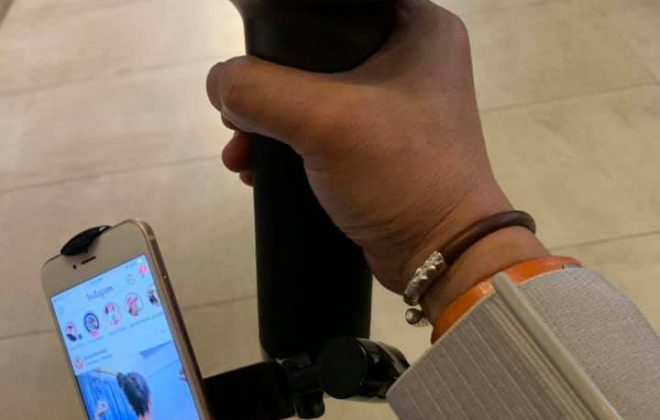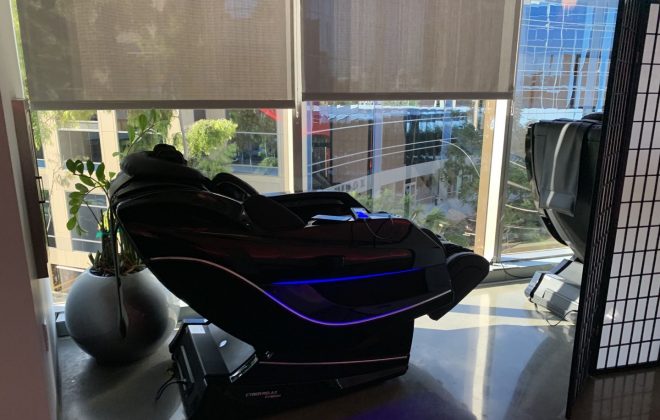Deep Muscle Stimulator for Fascia Therapy
Dr. Jeffrey Tucker
11620 Wilshire Blvd. #710
Los Angeles, CA 90025
310-444-9393
Deep Muscle Stimulator for Fascia Therapy
I see a lot of patients with poorly localized pain in muscles and joints with sensory disturbances that become worse after they have attempted exercise and/or stretching. Using the Deep Muscle Stimulator (DMS) as part of my in-office treatment is particularly useful for treating poorly localized muscle pain and decreased range of motion (ROM). If I can clear fascial restrictions and trigger points in the office, it makes the patient less vulnerable to hurting themselves during exercise. Reducing fascial adhesions and muscle tension makes my manual adjustments easier. Using the DMS over the soft tissues can reveal dense tissue, tender points, sore spots and trigger points but is not a painful treatment.
In my day-to-day practice I use the top tier Selective Functional Movement Assessment (SFMA) tests to me isolate decreased ranges of motion and painful regions within the musculoskeletal kinetic chain system. The SFMA is performed standing with the feet together (shoes off) and includes the patient moving through these ranges of motion: cervical flexion, extension, and rotation; shoulder flexion/external rotation and shoulder extension/internal rotation; lumbar flexion, extension, rotation; hip rotation; thoracic flexion, extension and rotation; a one legged stance for balance; and a squat assessment. The SFMA is easy to perform and only takes about three-four minutes to test and record. The SFMA is part of my objective evaluation and helps me decide on additional testing (called ‘breakouts’) that I may need to perform on the patient. It will also help me decide on the type of treatment needed, such as mobilization/manipulation, proprioception training, and exercise therapy. When I need to direct treatment to the soft tissues, I can use the DMS. The hand held DMS device is especially useful for decreased ROM revealed during the SFMA. I apply the DMS vibration and percussion over the muscles or chain of muscles suspected to be related to the decreased range of motion i.e., if the combination of cervical rotation and flexion are decreased I can start with the DMS treatment over the Levator scapula and Upper trapezius muscles. A simple re-test of the ROM will tell me and the patient if I am on the right treatment path. If I see the feet externally rotate and or the heels rise while the patient is doing the squat, I use the DMS over the bottom of the feet, gastrocsoleus and peroneals, all the while feeling for the tight muscles, dense tissues, taut fibers, and twitch responses within the muscles. If hip ROM is decreased, I use the DMS to check the hip capsules, piriformis, gluts, TFL, adductors and hamstrings. After a few minutes of DMS treatment I re-test the restricted or painful ROM. The test, treat with DMS, re-test routine is extremely useful for the in-office patient outcome.
The majority of the body ‘real estate’ I cover using the DMS is mostly the superficial fascia also called the hypodermis. This is made of loose connective tissue formed by a connective membrane that sheaths all muscles. It aids in muscle movements, provides passageways for nerves and vessels, provides deep fascia muscle attachment sites, and cushions muscle layers. This is the fascia with sensory nerve endings and is thought to be elastic as well as contractile. The DMS treatment influences the fascia that supports and stabilizes, helping to maintain balance. It doesn’t matter if the onset is acute (after a specific event) or chronic from overuse or poor posture. I use the DMS as an extension of my hands to feel for characteristic trigger points that are specific hyperirritable and tender spots within taut bands of skeletal muscle. Trigger points are often the cause of poorly localized muscle pain and stiffness.
I frequently ask patients “What percentage of your body is water?” Ask a few patients and see what number they think it is. I remind them that the body is approximately 70 percent water and it is possible for areas within soft tissues to become dehydrated. The ground substance tends to lose fluidity when it goes through trauma or an inflammatory response and it tends to become dense or solidify. The DMS is very useful at moving around fluids and mixing the fluids within tissues so that dehydration of the tissue is improved. Dehydration can put enormous and excessive pressure upon pain-sensitive structures and limit the fascial system’s ability to glide.
Dense fascial tissue, trigger points, and taut fibers are palpable through the DMS. If the patient tries to exercise or stretch these areas that are ‘all glued up” the tissue may have sensitive nerves within the interstitial spaces that are cemented and may become irritated when compressed or stretched. Releasing the dense, tight fascial structures with the DMS and then teaching my patients to perform at-home-stretches to maintain the fluidity normal fascial glide makes sense to the patient to comply with my exercise recommendations. The combination of DMS fascial release and home stretching exercises puts the patient at less risk of movement and sports injuries. When I reassess with the SFMA, patients feel the post-treatment effects and they understand that stretching or strengthening exercises reinforces what we did in the office.
The trend within all popular soft tissue techniques (Radial Pulse Therapy or Shock Wave therapy, FAKTR, Laser, etc) is to apply the technique with passive and/or active movement. The DMS application starts with passive stretching techniques of the affected muscle(s). Position the patient for maximum decrease in muscle tension. Clearly identify the dense tissues or trigger points and mark them. Apply the DMS in a sweeping motion over the entire length of the affected muscle. Passively stretch the muscle by applying gentle pressure with the DMS. Repeat DMS until full range of motion is attained.
Dr. Jake Pivoroff is the inventor of the DMS and he explains that “My approach to myofascial release is directed at changing the viscosity of the ground substance and releasing the crosslinks. The DMS covers the Anatomy Trains fascial system very effectively.” While matrix reorganisation and improved collagen integrity are sometimes considered goals of rehabilitation, Dr. Jake (as he likes to be called) states “DMS therapy treatment has positive therapeutic effects such as change in tissue compliance, functional strength, innervation, and vascularity.”
If you are a ‘kinetic chain’ thinker, and deal with stubborn soft tissue cases, you will appreciate the common measurable change in reduction or perception of pain and improved motion using the DMS and SFMA approach.




